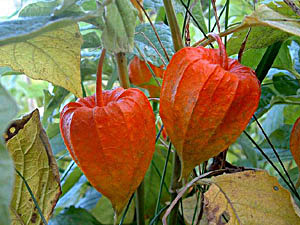
medicinal herbs
Winter Cherry
Physalis alkekengi

Herb: Winter Cherry
Latin name: Physalis alkekengi
Synonyms: Physalis franchetii
Family: Solanaceae (Nightshade Family, Potato Family)
Medicinal use of Winter Cherry:
The plant has a long history of herbal use, and an interesting chemistry, but it is seldom used in modern practice. The whole plant is antiphlogistic, antipyretic, antitussive and expectorant. It has been used in the treatment of urinary and skin diseases. Some caution is recommended since an overdose of the plant is said to easily precipitate an abortion. The fruit is aperient, strongly diuretic and lithontripic. It is used internally in the treatment of gravel, suppression of urine etc and is highly recommended in fevers and in gout. The fruit is harvested when fully ripe and can be used fresh, juiced or dried. The calyx should be removed. The leaves and stems are febrifuge and slightly tonic. They are used in the treatment of the malaise that follows malaria, and for weak or anaemic people. The fresh leaves have been used externally to make soothing poultices in the treatment of skin inflammations. The seed is used to promote early labour. A homeopathic remedy is made from the fruit. It is used in the treatment of kidney and bladder disorders.Description of the plant:

Plant:
Perennial
Height:
30 cm(11 3/4 inch)

Flowering:
JulyHabitat of the herb:
Cultivated ground and vineyards. Hedgerows and by damp paths, from the plains to the lower slopes of mountains.Edible parts of Winter Cherry:
Fruit - raw or cooked. Rich in vitamins, with twice the vitamin C of lemons, but not much taste. Another report says that they are juicy but with a bitter acrid flavour, whilst another says that they add a delicious flavour to salads. We have found them to be bitter and rather unpleasant. The fruit is a berry about 17mm in diameter. The plant conveniently wraps up each fruit in its own "paper bag" (botanically, the calyx) to protect it from pests and the elements. This calyx is toxic and should not be eaten. Young leaves - cooked. Caution is advised, the leaves are almost certainly poisonous, at least when raw.Propagation of the herb:
Seed - sow March/April in a greenhouse only just covering the seed. Germination usually takes place quickly and freely. Prick out the seedlings into individual pots of fairly rich soil when they are large enough to handle and plant them out in early summer. Diurnal temperature fluctuations assist germination. Division in spring. Very easy, larger divisions can be planted out direct into their permanent positions. We have found that it is better to pot up the smaller divisions and grow them on in light shade in a cold frame until they are well established before planting them out in late spring or early summer. Basal cuttings in early summer. Harvest the shoots with plenty of underground stem when they are about 8 - 10cm above the ground. Pot them up into individual pots and keep them in light shade in a cold frame or greenhouse until they are rooting well. Plant them out in the summer.Cultivation of Winter Cherry:
Cultivated ground and vineyards. Hedgerows and by damp paths, from the plains to the lower slopes of mountains.Known hazards of Physalis alkekengi:
All parts of the plant, except the ripe fruit, are poisonous.Plant information taken from the Plants For A Future.
